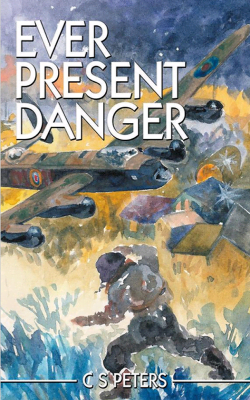www.CSPeters.co.uk
Ever Present Danger
What critics and Readers have said about Ever Present Danger:
“This novel is full of suspense, shock and thrills and leads to outcomes that no one in the Graham family could ever predict.”
“… Painstakingly researched throughout. … C S Peters allows the story to resonate with a wide audience by nicely blending action, excitement, romance and tragedy.”
“… the compelling juxtaposition of narrative of the action, trepidation and comradeship within the Lancaster’s crew and that of those below in occupied France is both poignant and gripping.”

A synopsis of the novel:
Ever Present Danger is the second part of the Graham family saga. It is now 1942 and finds James Graham coming to terms with his new individual role in the Second World War. A role, like his first as a Fighter Pilot, with its immense inherent risks and dangers. This time, though, the risks and danger come from his work as an SOE operative behind enemy lines in occupied Europe, where there are constant, fatal risks both to himself and others either working for the French Resistance or Evasion and Escape Lines in their desperate attempts to thwart the terrible endeavours of the occupying German forces and Gestapo.
James’s brother Colin is now embroiled in the horrors of the War as Captain of a Lancaster bomber, just one of many aircrew who, night after night, take off on missions to bring the War to a close. In so doing, he sees mass destruction and tragedy not only to those comrades around him in Bomber Command but, also, thousands of feet below in occupied territory.
Events arise which see both brothers’ lives once more threatened and unknowingly entwined and with their fates and those of their family forever sealed.
Excerpts from the book: Excerpt 1:
“As soon as he spoke, ahead and to starboard, pillars of light pierced the darkness, flashes of orange mushroomed in the now lightened sky. Like rolling thunder, above the beating throb of the aircraft’s engines, came the thudding sound of exploding shells. Suddenly the cockpit lit up as a searchlight beam dazzled Colin and illuminated every crevice of the flight deck. Darting streams of orange tracer streaked past the starboard wing tip. After a shout from Colin for power plus boost, they escaped the beam of dazzling light. The scream of the four Merlin engines vibrated through the bodies of the seven aircrew. There was a loud thud immediately below them as a flak burst exploded. The Lancaster heaved upwards, then immediately another thud, this time to port, which pitched it sideways. Whilst instinctively trying to shield his face, Colin fought to regain control and with rapid adjustments he eventually succeeded. With the turbulence of the explosions all around them it was like being tossed around in a barrel. Now another flak burst, above and to their right – its cascade of burning debris fell just behind the wing. Colin continued to weave the Lancaster around the shellfire and flak bursts. The combined noise of the engines and explosions were deafening; the flashes of shells and flak confusing and frightening. Suddenly, behind in the fuselage, there was a loud crackle and explosion. The Lancaster pitched violently; the control column was snatched from his hands.”
Excerpt 2:
“Sitting in the back of the Lysander, James heard the pilot call up on the radio confirming the course and heading. During the last few days, this particular pilot had been responsible for teaching James the technique and procedure for being dropped in occupied France …”
“… It was a clear night and James knew the pilot would have no difficulty in seeing the French coast-line clearly. As the Lysander climbed to avoid any possible light flak, James reflected on the briefing he received that morning in the cottage’s living room that served as the Op.’s/Crew Room. By now he knew his cover story and false identity as second nature. His code name to be used during communication by everyone was Merlin; the operational name for his drop-off was Phoenix. James hoped the message announcing his arrival had been heard by the Resistance. It would have been sent in code via the list of ‘personal messages’ broadcast after the BBC French language news programmes this evening. Hopefully they would, this very minute, be preparing for the Lysander’s landing. But SOE and he were all too aware of the German’s jamming of radio broadcasts. After landing in the field at Le Mont-St-Adrien near Beauvais, he would be met by members of the local Resistance group. After being hidden by them for a short while, arrangements had been made for him to travel first to Rethondes near Compeigne, onwards to Logny-Bogny, then Charleville which he would be using as his base and centre of operations. His first task after landing would be to distribute to the reception party two portable transmitters, some weapons, false papers and ration books the Lysander was also carrying …”
SITE MAP




